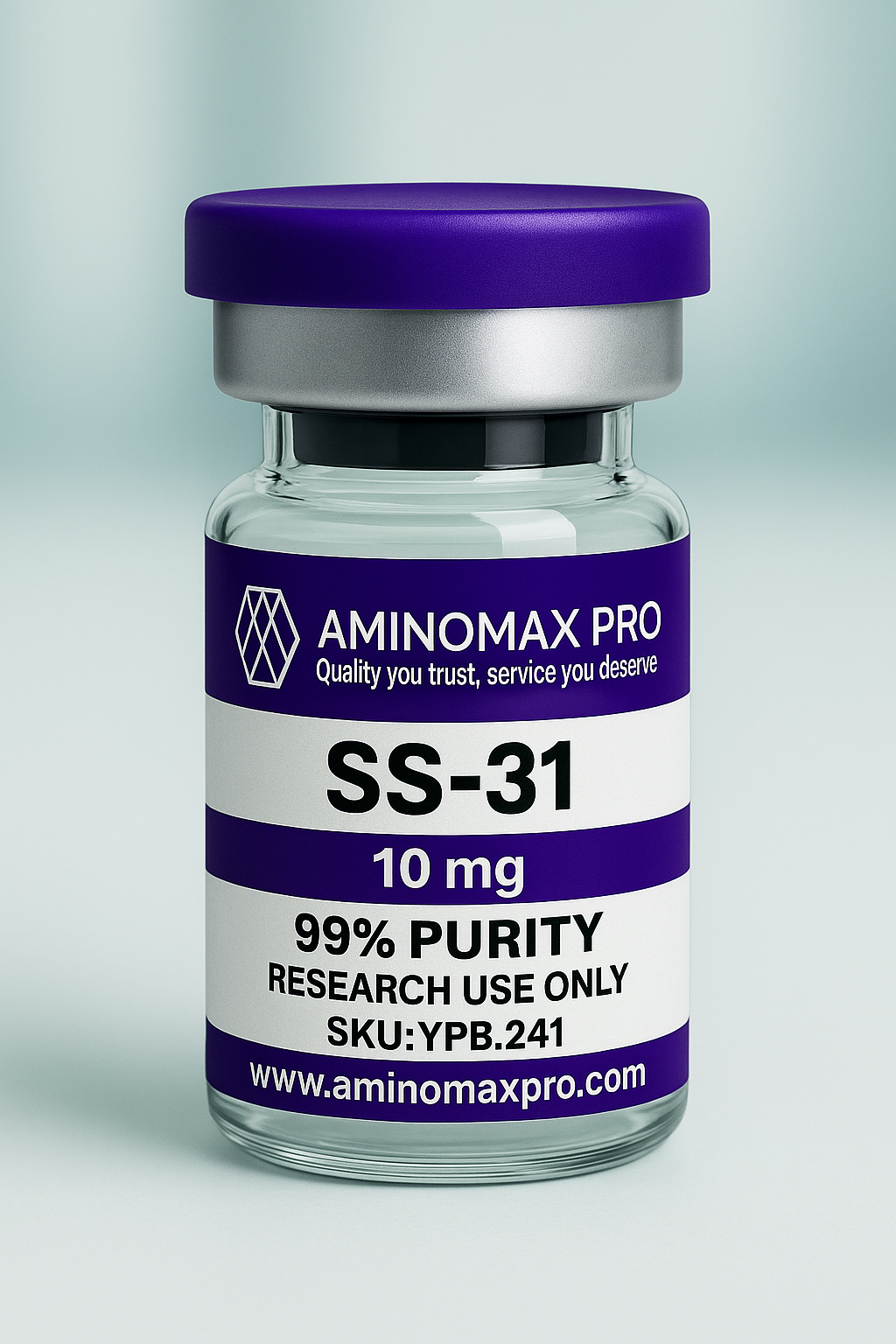Description
SS-31 (Elamipretide) – Technical Biochemical Mechanism Profile
(Mitochondria-Targeting Tetrapeptide; Cardiolipin-Binding Antioxidant Modulator – Research Use Only)
SS-31 (D-Arg-2’6’-dimethylTyr-Lys-Phe-NH₂) is a cationic, aromatic tetrapeptide designed to selectively target the inner mitochondrial membrane.
In vitro models show that SS-31 binds cardiolipin, stabilizing electron transport chain (ETC) supercomplexes and reducing oxidative leakage from Complex I and III, leading to modulation of ROS, mitochondrial membrane potential, and mitochondrial biogenesis pathways.
✅ 1. Primary Molecular Targets
| Target | Mechanistic Role |
|---|---|
| Cardiolipin (CL) | Structural phospholipid of inner mitochondrial membrane; anchors ETC complexes |
| ETC Supercomplexes (I–III–IV) | Electron transfer, proton pumping, ATP production |
| Cytochrome c | Electron shuttle; prevents peroxidase conversion under oxidative stress |
SS-31 binds electrostatically and via aromatic stacking to cardiolipin, preventing cytochrome c peroxidase activity and reducing mitochondrial ROS formation.
✅ 2. Core Biochemical Mechanisms
A. Electron Transport Chain Stabilization
-
CL binding → improved Complex I + III electron coupling
-
↓ electron leak → ↓ superoxide (O₂˙⁻) formation
-
Maintains mitochondrial membrane potential (ΔΨm)
B. Cytochrome c Modulation
-
Prevents oxidative cardiolipin peroxidation
-
Keeps cytochrome c in electron-carrier state
-
Limits caspase-linked apoptotic signaling
C. Mitochondrial Bioenergetics
-
↑ ATP synthase activity (via stabilized proton gradient)
-
Improved coupling efficiency within ETC supercomplexes
✅ 3. Enzymes, Complexes & Second Messengers
| Component | Relevance to SS-31 Mechanism |
|---|---|
| Complex I (NADH dehydrogenase) | Primary site of ROS generation; reduced leak under SS-31 |
| Complex III (cytochrome bc1) | Secondary ROS leakage site |
| Cytochrome c oxidase (Complex IV) | Maintained activity → electron flow efficiency |
| ATP Synthase (Complex V) | Improved ATP output per proton gradient |
| SOD2 (Mn-SOD) | Detoxifies mitochondrial superoxide |
| GPX1 / PRDX3 | Hydrogen peroxide detox systems |
| ΔΨm | Maintained membrane potential supports oxidative phosphorylation |
✅ 4. Signaling Pathways Influenced (In Vitro)
-
Nrf2/ARE antioxidant gene activation
-
PGC-1α / NRF1 / TFAM mitochondrial biogenesis axis
-
AMPK metabolic-stress signaling
-
Reduced activation of JNK and NF-κB inflammatory signaling
✅ 5. Gene Targets Commonly Measured in Research
| Functional Category | Representative Genes |
|---|---|
| Mitochondrial Biogenesis | PGC1A, NRF1, TFAM |
| Oxidative Defense | SOD2, GPX1, PRDX3, CAT, GSR |
| ETC Assembly | NDUFS1 (Complex I), UQCRC1 (Complex III), COX4I1 (Complex IV) |
| Lipid Remodeling | CLS1 (cardiolipin synthase), TAZ (tafazzin) |
| Apoptosis | BAX↓, BCL2↑, reduced CYCS release |
Research markers often show:
-
↓ lipid peroxidation
-
↓ cytochrome c peroxidase conversion
-
↑ mitochondrial respiration efficiency
✅ 6. Mechanistic Summary
-
Synthetic mitochondria-targeting tetrapeptide
-
Cardiolipin binding stabilizes ETC supercomplexes
-
↓ ROS generation at Complex I & III
-
Maintains cytochrome c as electron carrier
-
Supports Nrf2, PGC-1α, and mitochondrial biogenesis gene programs
-
Limits apoptotic signaling via preserved ΔΨm and reduced oxidative stress
✅ Research-Only Classification
SS-31 is supplied exclusively for in-vitro laboratory research.
Not approved for human or animal use, injection, ingestion, or biological application.


